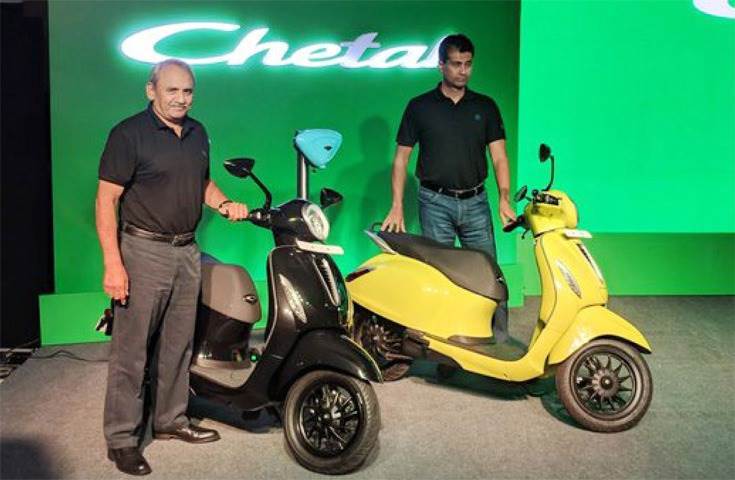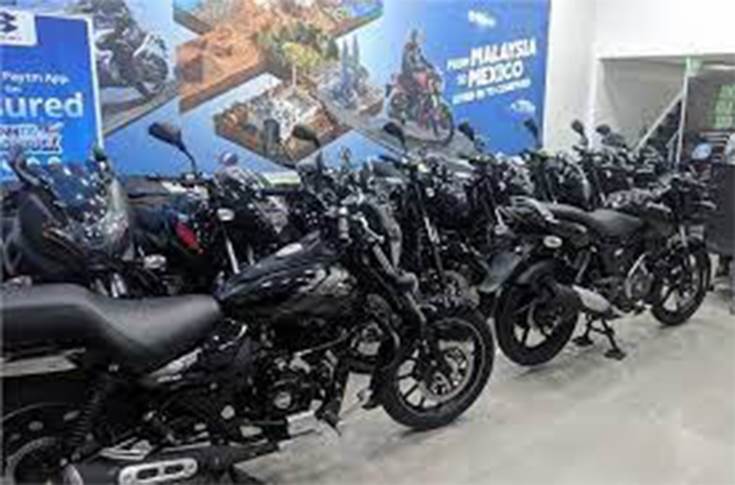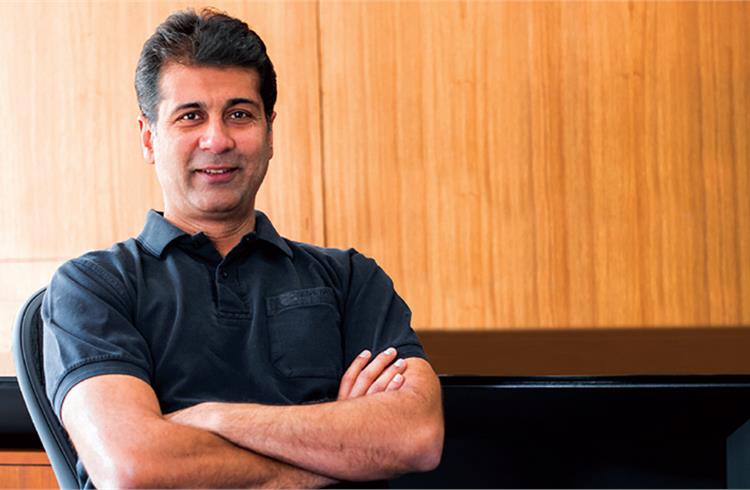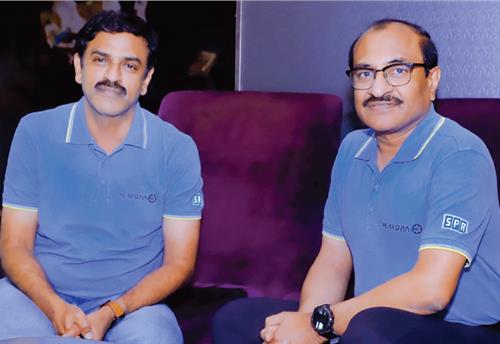Rajiv Bajaj: 'What better example can you have of Atmanirbhar Bharat than Bajaj Auto?’
Rajiv Bajaj, Managing Director of Bajaj Auto speaks about the state of the domestic two-wheeler market, buoyancy in exports, the success in the premium motorcycle space and the plans for the entry-level segment.
Rajiv Bajaj does not mince words and pretty much says it like it is. In the process, he ends up being a lone voice in the industry on a host of issues, going back to the many lockdowns imposed last year when he made it quite clear that the biggest casualty would be the economy.
Fast forward to the present and Bajaj Auto’s managing director maintains his stance that it is too early to be popping the champagne, at least as far as the two[1]wheeler domestic market is concerned. “As you recall, I have only been stating the facts. . . and the facts are that the domestic market is still in de-growth mode compared to last year and we all know that last year itself was not great since the auto industry was already in de-growth,” he emphasises.
There is further de-growth now, he adds, while indicating that the reasons for this are very clear. “One is that, as I have been saying over the past two-and-a-half years, the price of an average two-wheeler has gone up by 35 percent and so obviously if it becomes so much more expensive in such a short time, that will clearly have an impact,” explains Bajaj.
Two, he points out that in the process of the lockdowns when jobs were lost and salaries cut, it was not the vice-presidents who got impacted but the frontline workers and junior staff. “When production goes down, you don't sack the general manager but you end up downsizing the workforce — the frontline staff and workmen. And these are the people who buy two[1]wheelers,” says Bajaj.
Hence, these two reasons of high costs and impact of lockdown have hit sales; cars are not affected because the general manager is still buying a car but two[1]wheelers are impacted. As he adds, that is the reality which is being reflected in the numbers.
Is it all doom and gloom then in this scenario or is there still a likelihood of the proverbial ray of light shining through the clouds? Bajaj says it is impossible to predict anything at this point in time. “It is very difficult to say because nobody is able to see what will happen next month. So, we cannot forecast what tailwinds will occur and at which point in time,” he points out.
Right now, all “we can say” is that as far as domestic business is concerned, it is still in de-growth mode whether it is motorcycles or three-wheelers. “I have already explained the reasons for the former while in three-wheelers, it is because metros are their main market and they (metros) have not normalised completely,” says Bajaj.
Schools and colleges are still not open while offices and IT establishments are also not operational at normal levels. If that clientele is not available to be ferried back and forth, obviously nobody is going to buy three[1]wheelers. The domestic market is clearly down and it is difficult to say when all this will ease out, he avers.
“There is so much uncertainty now and talk of new variants/mutations along with the vaccine. So, it’s best to take one day at a time,” reasons Bajaj. The fact that vaccinations have begun may augur well from the viewpoint of infusing self-confidence but there is still some way to go before a full-fledged economic recovery can even be realised. After all, there are challenges to be reckoned with in the form of high steel prices. “Costs have gone up and everybody has increased prices. Now there is talk of increasing them further from April 1 or thereabouts. It is one of the highest spikes in commodities in recent times,” says Bajaj. Further, costly petrol and diesel are burning a hole in customers’ pockets.
Exporting a success story
The good news for the company, however, is its exports numbers which have been clocking record highs over the last few months. The MD agrees that this is certainly something to be pleased about but insists it is perhaps better to take one thing at a time.
“As far as exports are concerned, it’s so far so good but we should still wait and watch. We have to see how things evolve. We must remember that for the first three months, we could not export anything and we are seeing some of that pent-up demand also . . . to that extent 250,000 units a month is not the new normal and I would say that it is still 200,000 units only,’ says Bajaj.
If numbers have exceeded during the last few months, it is simply because April, May and June 2020 were very close to zero. “If you take the average for the year, it is below 200,000 units but now it is inching towards that mark. It is definitely a very good number,” he concedes.
By all standards, this is remarkable for an Indian company whose motorcycles and three-wheelers are shipped out to a host of countries across the world. Bajaj puts this in perspective . . . “I would think it comes down to our strategy to be a global player which means in simple words you focus on one product line and de-risk markets.”
This is what the company has hugely benefited from relative to others, which is that while the domestic market is very much down for two-wheelers, export markets are fortunately doing well. “That is also the reason why we are doing well, thanks basically to exports,” he sums up.
Given the recent clamour about Atmanirbharta and the need for self-reliance, the company has clearly walked the talk for some years now. “For us, Atmanirbhar is less of an inspiration for Bajaj Auto but I think Bajaj Auto is the inspiration behind Atmanirbhar Bharat. What better example can you have of Atmanirbhar Bharat than Bajaj Auto?” asks its MD.
Electric avenue
Beyond exports, the other bit of positive news coming in for the company is the heady market response to its Chetak electric scooter. Bajaj is doubtless pleased terming it “a good start” but is quick to add that its presence is still confined to Pune and Bangalore, which means the real big nationwide splash is still a while away.

“Unfortunately, with the supply chain disruptions especially of imports it is a challenge . . . some of the electronics is imported because it is not made in India by anyone. This is why production has suffered and it will take quite a few months to get it back on track. Hopefully, in the next financial year, things will be on course once more,” he says.
For now, customers are delighted with the Chetak even though the new smarter electric avatar is a far cry from the conventional geared scooter of yesteryear which ruled the roost for years. Once the motorcycle revolution set in, Bajaj Auto gradually exited scooters and chose to focus on motorcycles. Now, with the revival of the Chetak, the market is clearly delighted.
“People are very happy and we did the right thing by creating its own identity on the retail side with KTM and Husqvarna . . . it would have been lost otherwise in a Bajaj showroom,” says the MD. In a way, the company is “doing basically the same thing” it did 10 years ago with KTM. This was the time it created a separate channel and the hard work has yielded rich dividends in the form of 600 dealers for KTM and Husqvarna.
“That seemed the longer route to take at that time but it has paid off. Once again, creating a unique differentiated identity for Chetak (since it is an electric vehicle), a unique brand in a unique and exclusive channel with an exclusive customer experience is the right thing to do,” reiterates Bajaj.
The customer seems to echo this sentiment too given that the feedback over the last year clearly suggests that “we did the right thing”. Amidst this encouraging setting is a cause for concern. While there are still “lots of bookings”, the supply chain disruptions on imports have proven to be a big obstacle.
“We are not able to fulfill the orders but are doing our best. As soon as those restrictions are overcome during the course of next fiscal, we will definitely expand aggressively,” says Bajaj. The company is keen on opening up the next 20-30 cities because “we sense enormous interest in the product”. Right now, the focus is on scaling up the Chetak and reach out to more buyers across India.

In what has been a Covid-impacted fiscal, Bajaj Auto has clocked total sales of 1,979,936 two-wheelers in the domestic market (-18%) and exported 1,756,656 units (-6%) in the first 11 months of FY2021.
Triumph of midsize bikes
The other critical project underway is the alliance with Triumph Motorcycles of the UK which will see production of mid-capacity bikes both for India and a host of other markets. “The development work is going on and we have said that there could be some delays because of the time lost in the lockdown. We are still some time away from the start of production but development is going very well, products are coming together nicely and we are now ready to soon start work on Chakan 2,” he says.
In all probability, Triumph will start off from this new facility, where the company recently announced an investment of Rs 650 crore, and hopes to have it ready by 2023. The first plant in the same Chakan area is already home to KTM, Husqvarna and other Bajaj brands. It is clearly a key manufacturing powerhouse since it is from here that bikes are shipped out worldwide.
“KTM and Husqvarna are doing very well. What we develop and make in India is doing very well and the bigger bikes produced in Austria are likewise doing well. It is really outstanding work,” says a pleased Bajaj. The company will be hoping to pull off an encore with the Triumph partnership too and as its MD says, “As of now, things look promising”.
Whilst on the subject of premium bikes, Bajaj Auto has been positioning its 250cc trio of KTM, Husqvarna and Dominar as part of a new proposition for customers in its commercials. “From our point of view, we created the 150cc segment with Pulsar and felt the time had come to create the 250cc segment now explicitly,” he explains.
Obviously, the scale and volumes are initially small which explains why “you don't see too much communication” when it comes to premium brands whether “they are Ducati, BMW, Harley or even the bigger bikes from Honda and Yamaha”. As Bajaj points out, volumes are so small that media costs become killing.
“In our case, this is a smart move where between KTM, Husqvarna and Dominar, we are selling around 12,000 vehicles every month. If we can quite simply, from a consumer point of view, create a half-proposition of a 250cc segment and encourage people . . . just as they went from 100cc to 150cc, we are telling them that maybe you should now move from 150cc to 250cc,” he says.
After all, it is 20 years since the Pulsar was created and the market is ready to evolve to the next level — this is from the consumer point of view. From the company’s point of view, “when we put three brands together”, it obviously becomes very affordable. . . once the media costs are spread over that kind of volume, it “makes business sense and that was the thought behind it”.
The Dominar is sold at the Bajaj channel since it is branded a Bajaj Dominar while the KTMs and Husqvarnas have a common channel for themselves — the Probiking outlets. As Bajaj says, the channels may be different but the consumer knows where to find what and this is not a problem for them.
“What we are saying to them is that it is horses for courses. If you want ready-to[1]race bikes or adventure bikes, KTM is the best bet. On the other hand, if you want very sharp and stylish and typical Scandinavian products for the cities, go in for Husqvarna. And if you want a big bike to tour, buy the Dominar,” he elaborates.
Clearly, this strategy is working because this portfolio is growing at 50-60 per cent year-on-year for the company. At this time last year, KTM plus Husqvarna plus Dominar was something like 6,000 to 7,000 bikes a month and today it is in the range of 12,000 units.
“Again, it comes down to the same point that it is not the frontline workers or staff who are buying these bikes “Despite this, we are growing at 50-60 per cent otherwise we would probably be growing at 100 per cent. And as far as the shortage of containers is concerned, there seems to be no end in sight for now,” adds Bajaj. The new marketing strategy for the 250cc range has come as a huge boost to the Dominar brand which was, till recently, present in its solo 400cc version. Today, even while its base is very low, it is “perhaps doing 200- 300 percent” of the volumes it was doing earlier. This, in his view, is the “contra-intuitive thing” about marketing. “We did introduce the 250cc with the hypothesis that there are some people who would like but those who are a little more affluent. This category of buyer is not affected and the segment is therefore growing like the car market,” says Bajaj. Hence, when people say there is a three[1]month waiting for a particular car model, “we will be at the same problem of prosperity” as far as KTM, Dominar and Husqvarna are concerned.
While this range is growing at over 50 percent, the company is still losing production every month due to supply chain problems. For instance, the estimated numbers lost for KTM in February, between domestic and exports, are in the range of 6,000 bikes because of shortage of semiconductors and ABS parts from Bosch.
“Despite this, we are growing at 50-60 per cent otherwise we would probably be growing at 100 per cent. And as far as the shortage of containers is concerned, there seems to be no end in sight for now,” adds Bajaj.
The new marketing strategy for the 250cc range has come as a huge boost to the Dominar brand which was, till recently, present in its solo 400cc version. Today, even while its base is very low, it is “perhaps doing 200- 300 percent” of the volumes it was doing earlier.
This, in his view, is the “contra-intuitive thing” about marketing. “We did introduce the 250cc with the hypothesis that there are some people who would like to graduate from 150cc to 250 but are intimidated to go all the way to a 400,” continues Bajaj.
To that extent, the 250cc has worked very well and that is the intuitive part. The contra-intuitive part is that the sales of the 400cc have also gone up and there is no cannibalisation at all. “If we were selling a thousand Dominars last year, we are selling 2,500 this year in which the 400cc has gone up and the 250cc has also gone up,” he says.
How does this happen? According to Bajaj, this is because of two reasons: one is because the dealer is suddenly able to stock both the 250 and 400cc (smaller dealers could not stock just the 400cc earlier because they hardly had any sales). “The first problem you overcome is the distribution problem," he says.
Two, from a consumer point of view, in relatively smaller places where people could not have the confidence to ride a 400, they have bought a 250 and this has created awareness that “this is a nice bike”. Someone else sees this happening and decides to do one better by going for the 400cc. “This is what happens and, in the process, you overcome first the distribution hurdle and then the awareness hurdle,” he adds.
Keeping a finger on the customer’s Pulsar
As Bajaj puts it in perspective, when a company introduces something like a 250cc motorcycle, people normally think that sales of the 400cc sibling will go down but this is not the case. “We have seen this multiple times with the Pulsar and Avenger where when you expand the portfolio smartly, not only does the new SKU (stock keeping unit) add to volumes but the volumes of the existing one also go up because you overcome distribution and awareness hurdles,’ he explains.
The same behavioural pattern was evident when the Pulsar was launched and it is today selling like hot cakes. “Yes, it has done very well again and in the 150cc and above, Pulsar has held its own while at the same time with the 125cc (where we were absent in that segment), today we have a 25 percent share there, which is remarkable,” says Bajaj.
Once again, this means that in the domestic market alone, the Pulsar brand is typically clocking nearly 100,000 units a month which is “fantastic”. As he adds, “With these kinds of volumes, we will never get out of the sports segment.” The Pulsar is clearly the leader of the pack when compared to rival models like TVS Apache, Yamaha FZ or the Honda Unicorn.
From Bajaj’s point of view, this is equally important for three reasons. One, when there are volumes in place, dealers can stock and the distribution problem is overcome. Two, there are people who want to go beyond a 100cc but are scared of the 150cc proposition and settle for a 125cc which in turn brings in the additional customers. “In the process, the awareness issue is getting resolved,” he adds.
And, finally, profitability and EBITDA get a boost, “that is why we had the best quarter in our history last quarter” because of the same fixed cost of manufacturing, advertising. “When I release an ad in a newspaper or during a cricket match, whether my volume is 20,000 or 80,000 units a month, the ad costs are the same. When the volume is four times, the per unit cost comes one fourth and the profitability goes up,” he sums up succinctly.
What is especially pleasing to the company is that whether it is Dominar 250, Pulsar 125, KTM 125, Husqvarna 250 . . . ”all these moves we made” were conceived during the lockdown and implemented in the few months after it. Thus far, everything is working well and in sync with the script.
The challenge now is the elusive 100cc space where Hero MotoCorp is clearly the leader with its Splendor and HF brands. Bajaj has the CT and Platina as its options here but the gap is still considerable vis-a-vis the market leader’s offerings in this space.
“Definitely in March and April, we will make some big moves with both Platina and CT. Hopefully, the success we have had with all the brands discussed already (Pulsar, Dominar, KTM and Husqvarna) will be repeated here too. I am confident that we should be able to strike similar success with these two brands too. . . let’s see,” says Bajaj.
He does not buy into the argument that there could be perception issues when it comes to buying entry[1]level motorcycles from a manufacturer that is more in the premium space. “There are two things we need to keep in mind: one, we do not sell as Bajaj but think as CT, Platina, Pulsar or Dominar. We always think in terms of the consumer brand because that is how they think,” he replies.
This, in his view, is the reason why the company has been able to succeed with Pulsar, Avenger, KTM, Husqvarna and “possibly Triumph tomorrow”. It is also Bajaj’s contention that rivals like to think as their corporate brand and put this proposition in front. Consequently, this “becomes a problem” when it is associated with a 100cc bike and then attempted to take forward to the sports bike category too.
“This is the first difference where ours is a very segmented approach whereas some rivals have a corporate brand approach,” reasons the Bajaj Auto chief. Two, he continues, it is “well known in marketing” that brands travel very well downwards but not upwards which means that “if Volkswagen makes an expensive car, people are unlikely to buy it”.
However, says Bajaj, when Audi makes a smaller car, people “fall over each other” to buy it. Likewise, when Mercedes makes an A-Class, they are as delighted because they can afford a Mercedes. Similarly, when Maruti makes a big car, nobody wants to buy it because “there is no prestige” in it.
“Hence, when the maker of a 100cc bike makes a bigger motorcycle it may not work but when the maker of a Husqvarna, Dominar, KTM or Pulsar makes a 100cc bike it will work,” declares Bajaj, while signing out.
This feature was was first published in autocar Professional's March 15, 2021 issue.
RELATED ARTICLES
BRANDED CONTENT: Eliminating the worries of battery charging with smart solutions
The charging infrastructure is the backbone of electric mobility but is also one of the key perceived barriers to EV ado...
The battery-powered disruptor
Greenfuel Energy Solutions is planning to shake up the EV battery market with the launch of a portfolio of specially eng...
SPR Engenious drives diversification at Shriram Pistons & Rings
The engine component maker is now expanding its business with the manufacturing of motors and controllers through its wh...





 25 Mar 2021
25 Mar 2021
 22289 Views
22289 Views





 Autocar Pro News Desk
Autocar Pro News Desk




